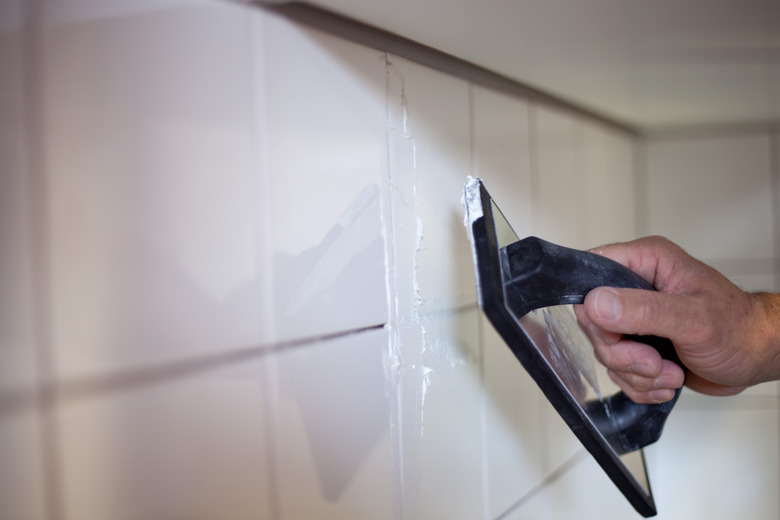Why Does Grout Color Fade As It Dries?
The color of your tile isn't the only color decision you need to make for the project. You'll also need to choose a grout color to fill in the joints between the tiles. But the grout you see when you're working isn't always the final color you'll get. Will grout dry darker or lighter? It's usually lighter than what you see in the bucket due to the drying process.
Why Grout Dries Lighter
Why Grout Dries Lighter
The most common tile grouts are made with Portland cement. Some are smooth and some contain sand. Smooth, unsanded grout is used to fill narrow seams, called grout lines, and sanded grout makes wider grout lines between floor tiles stronger. Both kinds of grout are mixed with water, which makes the grout appear darker while it's wet. As the water evaporates, the grout returns to its natural color, which is the color of the dry powder before it was mixed.
The amount of water you use in the grout can also affect the color. If you add extra water, it can dilute the pigment, causing the grout to look lighter. You can also remove some of the pigment if you use too much water when you're cleaning off the tiles. If you want the true, darker color, follow the mixing directions and be careful during the cleaning process.
Other factors also come into play. The tile material can cause the grout to dry at different rates, which sometimes causes patchy coloring or an overall lighter color. If the tile draws out lots of moisture before the grout cures, it tends to look lighter. Porous natural stone tends to suck the moisture out of the grout faster than dense stone tiles. If you're using two different types of tiles, you might notice different colors in each area because of the different absorption rates. The substrate material can have the same effect, pulling water out of the grout before it fully cures, which leaves it looking lighter than expected.
Even the lighting in the room can make the dried grout look different. In some light and from certain angles, the grout might appear much lighter than you anticipated. You might notice a difference in how light or dark the color looks depending on whether it's under natural light or artificial light.
Don't Trust the Color Swatch
Don't Trust the Color Swatch
Color swatches on the side of the grout package are printed with ink or applied with paint, so they are subject to inconsistencies. Sometimes, there is a powdery residue along the sealed edge of the cardboard container or paper bag.
When enough residue is present, use its color as a guide to make a better selection. If the swatch is charcoal and you want charcoal, but the residue is almost white, choose a darker shade. Chances are the grout in that container will dry almost white, like the residue.
If you must use the color swatch to choose, keep in mind that there is no way to know whether the grout will dry lighter or darker than the swatch because the swatch is not grout at all. Testing the grout in a small hidden area gives you an accurate way to see if it's the color you want.
Always Check the Batch Number
Always Check the Batch Number
Buy enough grout for the whole job at the same time, and check the batch number on the packages. Grout is subject to color variations from batch to batch. If you buy different batches and mix them separately, your grout will probably dry with a lighter color in at least one area, even if they look the same wet.
If you can't find enough packages of the same batch, put all the powdered grouts together in an airtight container, and mix as much as you need a little at a time. Although the grout will still dry lighter, the finished job will be a uniform color.
Apply an Enhancing Sealer
Apply an Enhancing Sealer
If the grout dries lighter than you want, you may be able to darken it without redoing the job. Apply enhancing sealer to help darken the color of dry grout. Although it may never be as dark as it was before it dried, the sealer will help change the grout color to a deeper hue and block stains. The most common grout sealers will not darken grout because they are formulated to dry invisibly. Check the label to be sure yours is an enhancing sealer.
Consider Epoxy Grout
Consider Epoxy Grout
Skip the cement grout and avoid dramatic lightening with a product called epoxy grout. Epoxy grout is expensive compared to cement grout and it is more difficult to work with, but the durability and stain resistance are worth it for some homeowners. Epoxy grout is usually premixed and doesn't contain water.
The first epoxy grouts made many homeowners and tile setters nervous because they dried fast and stuck like glue to everything they touched. Some newer epoxy grouts contain detergents to make the cleanup easier, but they still have a shorter working time than cementitious grouts. Once it is cured, an epoxy grout is set for life, so clean up residue as soon as possible.
Even though the water content in grout tends to make it dry a lighter color, you can take steps to get the color you want. Anticipate the lighter finished color to make sure your grout lines look as dark as you want.
